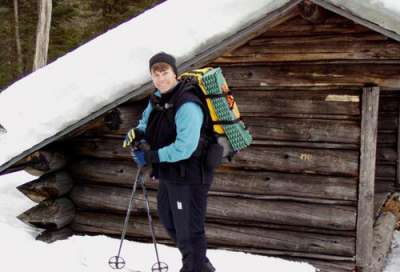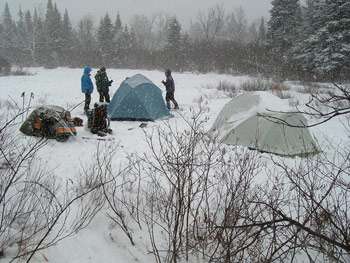In winter, Lynn Malerba’s peak experiences don’t occur on mountaintops. Her idea of a great February weekend is to teach a small group of novice explorers how to thrive on the valley floor, by confronting the challenges of winter camping.
Malerba is a New York State Licensed Guide, and to make the title more distinguished, she’s an Adirondack guide, following a proud tradition of rugged, never-say-die outdoorsmen and women who lead adventurers into the wilderness regions of the Adirondack Park.
Malerba explains that when she left teaching in 2001, it wasn’t because she didn’t like her job as a physical education instructor. She loved teaching. But after a 20-year career, she longed to spend more time outdoors – backpacking, canoeing, cross-country skiing, and snowshoeing in the Tupper Lake region wilderness where she grew up. The dilemma perplexed her for years until a friend suggested that she combine her passions for the outdoors and education. The conversation changed Malerba’s life. First she worked toward attaining her guiding licenses in canoeing, camping, and hiking. Then, in 2002, she opened her four-season guide service, Adirondack Connections.
A few miles from the village of Tupper Lake, Malerba’s family owns over a hundred acres on the Raquette River, the second longest river in New York. The Raquette flows north through wild country – a land of lowland fens, marshes, bogs, and forests. The family property borders state-protected “Forever Wild” land and is an excellent launching site for Adirondack Connections’ wilderness adventures. Paper birches, silver and red maples, balsam firs, and alders dominate the landscape.
Malerba has been at home in the woods all her life. From the time she was four years old until she was in high school, she joined her father, a forester, on trips to mark trees in the lowland boreal forest northwest of the Tupper Lake Region. Malerba remembers carrying cans of paint in a canvas backpack and trooping along behind him. “There weren’t any trails, so every trip was a bushwhack,” she says. “Dad made me appreciate the value and importance of trees.” An avid hunter and fisherman, Douglas King also taught his daughter not to be afraid of wildlife.
In her own work, Malerba has carried on her father’s interest in teaching people to be comfortable in wild places. Her most popular winter adventure – the winter camping weekend – is not so much a trip as it is an experience, she says. Most attendees are beginners, and she has come to like it this way. Her primary objective is to teach her clients how to be warm and comfortable all weekend so that they can fully experience the joy of winter outdoor living in the wilderness. She hopes they will gain confidence, practice new skills, and try winter camping again.
Malerba begins the weekends by inviting her clients into the comfort of her home early Saturday morning. “I make sure the living room is warm and cozy so that people start the weekend feeling relaxed.” This is crucial, Malerba says, because she wants her clients to absorb what she’s teaching them, which would be difficult if they were outdoors shivering. She explains the essentials of keeping the body warm as well as the dangers of hypothermia, and she discusses the reasons why she has asked them to bring each item of clothing and gear.
“How to Stay Warm in a Sleeping Bag,” is the most important winter skill she teaches, Malerba says. Adirondack nights are infamous for dropping lower than expected. “It’s crucial to have a bag that fits,” she explains. “If it’s too big, your body can’t warm the air spaces around you. To stay warm, you should have just enough room to squeeze into it while wearing layers of microfleece from head to toe. You also need space to hold the next day’s clothing close to your body.”
And what if the bag is too big? “Cram the foot of the bag and all extra space with dry clothing.” She also cautions her clients about the dangers of sweating and the importance of removing a layer of clothing before becoming drenched.
As soon as her weekend group is dressed warmly and has their gear packed, they drive or snowshoe to the wild area where they’ll carefully select a campsite near the Raquette River, near the Bog River, or close to Bog Lake, all within 10 miles of her home. She helps them choose a tent site that’s protected from wind and clear of overhanging branches, which may have become brittle from cold. She also gives each tent’s occupants a small shovel to keep by the opening in case wind drifts snow in to block the exit overnight.
After a lunch at the campsite, everyone enjoys an afternoon snowshoe trek, usually over a frozen pond and wetlands. Malerba encourages the hikers to observe the snow ahead of them as they proceed. If the consistency of the snow changes—if it becomes crystalline or if a depression appears—there may be a hole in the ice beneath the snow. She also warns them to avoid rocky areas that attract heat during the day. For extra safety, she suggests snowshoeing in shady places wherever possible.
The group then heads back to camp to build a fire, prepare hot beverages, and make dinner – all tasks that require special cold-weather strategies.
Sundays include breakfast, more exploration, lunch, and another short hike before driving back to Malerba’s home. In past years, she’s allowed the groups to fill to a maximum of six people. This winter, she’s reducing it to four people. “Six is workable,” she says, “but with four, everything is more manageable and allows me to give my clients more individual attention.”
“The magic of these winter weekends is that they’re new for me each time,” she says. “I just love watching people try something new and enjoy it. For me, it’s partly helping them through their fear of the unknown – surviving a cold winter’s night outdoors and having fun doing it. On Sundays, toward the end of the trip, I’m thrilled to hear how excited they are about the experience. They beam.”
In the spring, summer, and fall, Malerba guides “pond-hopping trips” with her Hornbeck boats. Hornbecks are built in the southern Adirondacks and are famous for their light weight and portability, durability, and ease of use.
Any professional guide will tell you that it’s a spartan, demanding life. Finding clients is the greatest challenge. And dedicated attention to the business details is what makes or breaks a guide. Survival in this business is all about marketing – targeting the most appropriate advertising outlets, maintaining a website (Malerba designed her own), appearing at outdoor sports expos, and most importantly, responding quickly to email from prospective and former clients.
These tasks gobble up time and are never done. Striking a balance is difficult, Malerba says. Sometimes she must sacrifice the days she needs to spend scouting new trips. At other times, she has to postpone the cross-country skiing, hiking, and paddling that help maintain her top-notch physical condition. What’s unusual about Malerba is that she has persevered in clocking the desk hours that make Adirondack Connections a success.
Active participation in the New York State Outdoor Guides Association (NYSOGA) has helped her master other aspects of the guiding life. She now serves on the board of directors and helps other guides learn wilderness first aid, build rapport with clients, and advertise their skills.
Malerba’s dreams for her business have changed over the years. Three years ago, her goal was to make a simple living and keep her business afloat. As Adirondack Connections has steadily grown, her dreams are changing. “I love exploring new places,” she says.
Last August, Malerba led four trips, each lasting a week, in Acadia National Park in Maine, adventures that combined bicycling, mountain climbing, sea kayaking, and hiking, with plenty of free time for sightseeing, sunbathing, or relaxing. She says it’s a joy to work in Acadia, the place that “has it all.”
Malerba plans on further expanding the scope of her guiding service. “I’d love to guide on the John Muir Trail in the Sierra Nevadas,” she said, “and take clients to hike portions of the Pacific Crest Trail.”
Yet she admitted that she can’t imagine life without the unique beauty of the Adirondacks. “It’s so peaceful here,” she said. “I can take my clients to wild places and we rarely see anyone. People are always amazed by that and I think it makes them feel even closer to nature.”




Discussion *